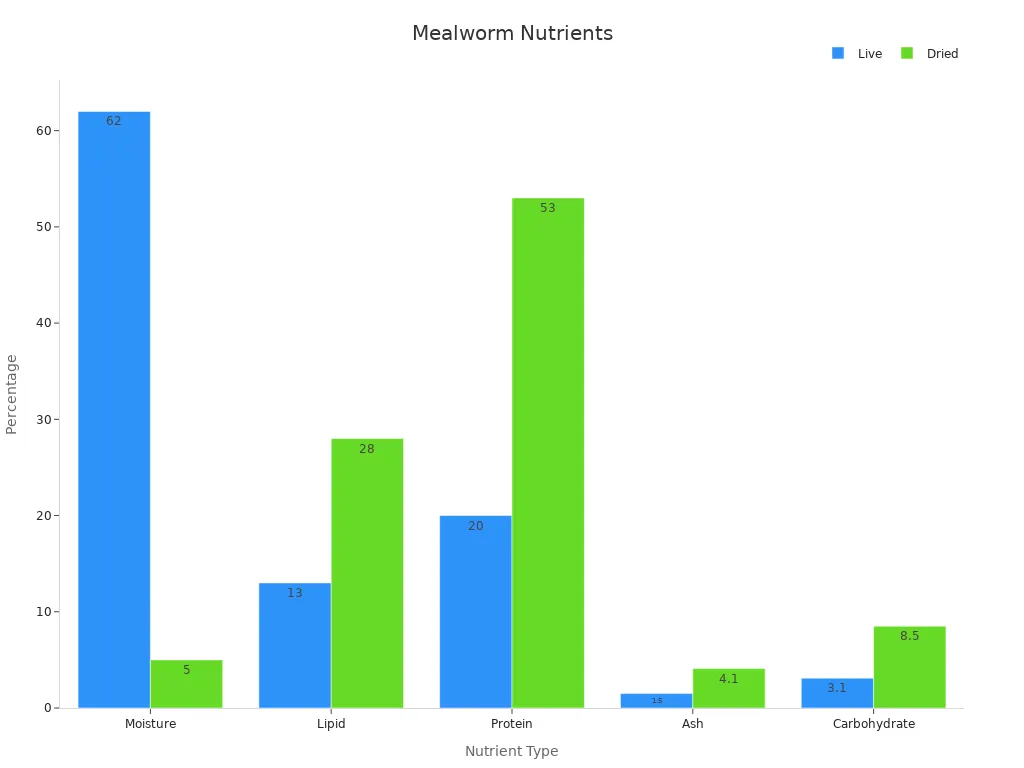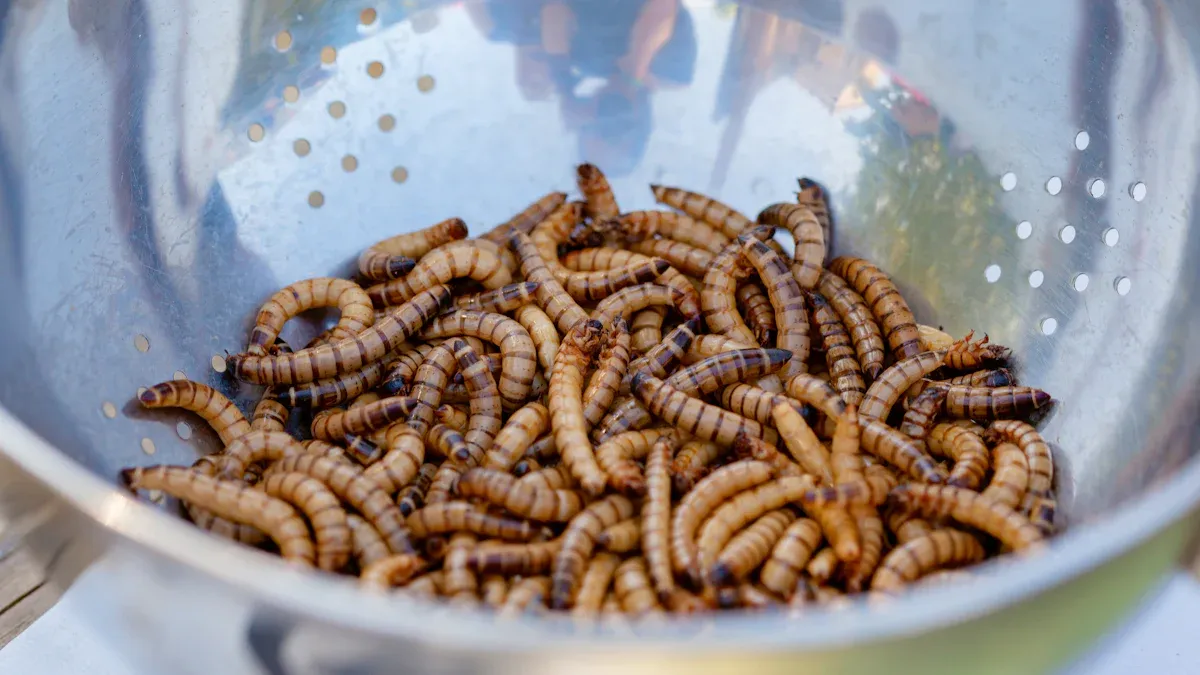
Mealworms for pet health provide a delicious and nutritious snack that is rich in protein and essential nutrients. These small insects boast a protein content of up to 52.3%, along with 19% fat, which aids in energy levels and promotes healthy skin in pets. Additionally, their eco-friendly farming process makes them a responsible choice, allowing pet owners to care for their animals while being mindful of the environment.
Key Takeaways
- Mealworms are full of protein, offering 53% protein and 28% fat. They help pets stay active and build strong muscles.
- These bugs are simple to digest and help with digestion. They are great for pets with weak stomachs.
- Picking mealworms helps the planet since they need fewer resources. They are better for the environment than raising farm animals.
Nutritional Benefits of Mealworms for Pet Health
High Protein and Energy for Active Pets
Mealworms are a powerhouse of protein and energy, making them an excellent choice for active pets. With a protein content of up to 53%, they help build strong muscles and support daily energy needs. Pets that love to run, jump, or play can benefit greatly from this natural protein source. The 28% fat content in mealworms also provides a steady energy supply, keeping pets lively and full of vitality throughout the day.
For pets that need a little extra boost, mealworms can be a game-changer. Whether it’s a playful puppy, a curious bird, or a busy hamster, mealworms deliver the nutrients they need to stay active and healthy.
Tip: Introduce mealworms gradually into your pet’s diet to ensure they adjust well to this high-energy treat.
Essential Nutrients for Strong Bones and Vitality
Mealworms are more than just a protein source. They are packed with essential nutrients that contribute to overall health. Here’s what makes them special:
- High protein (53%) supports muscle growth and energy.
- Rich in fat (28%) for sustained energy.
- Loaded with vitamins and minerals, especially calcium, which strengthens bones.
- Contain essential amino acids that aid in tissue repair and boost immune function.
These nutrients work together to enhance your pet’s vitality. Calcium, in particular, plays a crucial role in maintaining strong bones, which is vital for pets of all sizes. The amino acids in mealworms also help pets recover from minor injuries and stay resilient against illnesses.
Adding mealworms to your pet’s diet is a simple way to ensure they get the nutrients they need for a happy, healthy life.
Digestibility and Gut Health Support
Mealworms are not only nutritious but also easy to digest. Their digestibility makes them suitable for pets with sensitive stomachs. Studies have shown that mealworms can positively impact gut health and nutrient absorption.
Here’s a look at some findings:
| Study | Findings |
|---|---|
| Khempaka et al. (2011) | Feeding broiler chickens shrimp chitin inhibited the growth of foodborne pathogens and Salmonella in the intestine. |
| Islam and Yang (2017) | Supplementing yellow mealworm and super mealworm reduced cecal E. coli and Salmonella spp. in broiler chicks. |
| Bovera et al. (2015) | Diets containing yellow mealworm induced immune response and better disease resistance in broiler chickens. |
| Kim et al. (2021) | Substituting soybean meal with black soldier fly larvae meal improved intestinal morphology and enhanced nutrient absorption. |
| Zadeh et al. (2019) | Feeding yellow mealworm positively affected villus height and crypt depth in Japanese quails. |
| Biasato et al. (2018) | Yellow meal supplementation had no adverse effects on gut health and could modulate gut microbiota in free-range chickens. |
These studies highlight the benefits of mealworms for gut health. They can reduce harmful bacteria, improve intestinal structure, and enhance nutrient absorption. For pets, this means better digestion and overall well-being.
Note: Always consult your veterinarian before introducing new foods to your pet’s diet, especially if they have specific dietary needs.
Sustainability of Mealworms for Pet Health
Environmentally Friendly Protein Source
Mealworms are an eco-friendly protein source that aligns with sustainable pet care practices. Unlike traditional livestock, mealworms require fewer resources to produce high-quality protein. They are part of the natural diet for many animals, making them an ecologically relevant choice for pet owners.
Here’s why mealworms stand out as a sustainable option:
- They provide up to 71% protein, making them a premium nutritional source.
- Farming mealworms generates significantly lower greenhouse gas emissions compared to livestock like cows or pigs.
- They consume less water, land, and energy, reducing their overall environmental impact.
By choosing mealworms for pet health, owners can reduce their carbon footprint while ensuring their pets receive a nutritious and natural treat.
Did you know? Mealworm farming emits far less CO2 than beef production—22 times less, to be exact!
Minimal Resource Use in Mealworm Farming
Mealworm farming is a game-changer when it comes to resource efficiency. Compared to traditional livestock farming, mealworms require minimal water, land, and energy. This makes them a sustainable alternative for pet food production.
| Livestock Type | Greenhouse Gas Emissions (GWP) | Energy Use (EU) | Land Use (LU) |
|---|---|---|---|
| Mealworms | Low | Similar to pork; lower than beef | Very low compared to milk, chicken, pork, and beef |
| Milk | 1.77–2.80× as high | 21–83% of mealworm | 1.81–3.23× as high |
| Chicken | 1.32–2.67× as high | 46–88% of mealworm | 2.30–2.85× as high |
| Pork | 1.51–3.87× as high | 55–137% of mealworm | 2.57–3.49× as high |
| Beef | 5.52–12.51× as high | 1.02–1.58× as high | 7.89–14.12× as high |
This table highlights the efficiency of mealworm farming. For example, the water footprint per edible ton of mealworms is 4341 m³/t, which is 3.5 times lower than beef. Additionally, mealworms produce less ammonia and greenhouse gases like methane and nitrous oxide.
Switching to mealworms for pet health not only benefits pets but also helps conserve valuable resources for future generations.
Supporting a Greener Future for Pet Care
Integrating mealworms into pet diets contributes to a more sustainable pet care industry. Their production has a smaller environmental footprint compared to traditional protein sources, making them a responsible choice for eco-conscious pet owners.
| Evidence Description | Environmental Benefit |
|---|---|
| Mealworm proteins as a substitute for traditional animal derivatives | Reduces environmental footprint of pet food |
| Nutritional benefits of Tenebrio molitor flour | Helps reduce environmental footprint by replacing other protein sources |
| Lower CO2 emissions from mealworm production | Emits half as much CO2 equivalent as lamb or soy flour, and 22 times less than beef flour |
Large-scale insect farming, including mealworms, could lead to significant reductions in greenhouse gas emissions. It also uses less water and land compared to conventional livestock farming. By choosing mealworms for pet health, pet owners can actively support a greener future while providing their pets with a nutritious and sustainable treat.
Tip: Look for pet food brands that incorporate mealworms into their products to make an eco-friendly choice for your furry or feathered friends.
Practical Tips for Adding Mealworms to Your Pet’s Diet
Choosing Between Dried, Live, or Powdered Mealworms
Mealworms come in three main forms: dried, live, and powdered. Each type offers unique benefits, so choosing the right one depends on your pet’s needs and preferences.
Live mealworms are ideal for pets that enjoy hunting or foraging. They contain 62% moisture, which helps with hydration, and 20% protein to support energy. Dried mealworms, on the other hand, are a concentrated source of nutrients. With only 5% moisture, they pack 53% protein and 28% fat, making them perfect for pets needing a high-energy boost. Powdered mealworms are versatile and can be mixed into pet food for easy consumption.
Here’s a quick comparison:
| Type of Mealworm | Moisture | Lipid (Fat) | Protein | Ash | Carbohydrate |
|---|---|---|---|---|---|
| Live | 62% | 13% | 20% | 1.5% | 3.1% |
| Dried | 5% | 28% | 53% | 4.1% | 8.5% |

Safe Serving Sizes for Different Pet Types
Serving sizes vary depending on the pet. Small pets like hamsters or birds should start with a few mealworms per day. Larger pets, such as reptiles or chickens, can enjoy a handful. Gradually increase the amount while monitoring your pet’s health and activity levels.
For pets new to mealworms, smaller portions help them adjust. Always consult a veterinarian to determine the best serving size for your pet’s specific needs.
Tip: Store dried mealworms in a cool, dry place to maintain their freshness and nutritional value.
Encouraging Picky Eaters to Try Mealworms
Some pets may hesitate to try mealworms. Mixing powdered mealworms into their regular food can help. For live mealworms, placing them in a foraging toy can make mealtime more engaging.
If your pet remains reluctant, try offering mealworms as a reward during playtime. Their natural flavor and texture often win over even the pickiest eaters.
Note: Patience is key. Gradual introduction ensures your pet feels comfortable with this new treat.
Mealworms offer pets a healthy, natural, and sustainable treat option. Their rich nutritional profile supports pet health while promoting eco-friendly practices.
- Packed with protein and essential nutrients, they enhance vitality.
- Their sustainable farming methods make them an environmentally responsible choice.
Pet owners can confidently choose mealworms to nourish their beloved animals.
Fun Fact: Mealworms are not just nutritious—they’re also a step toward greener pet care!
Article by Felix
FAQ
What types of pets can eat mealworms?
Mealworms are suitable for a variety of pets, including birds, reptiles, amphibians, small mammals, and even some fish. Always check with your vet first.
How should mealworms be stored?
Store dried mealworms in a cool, dry place. For live mealworms, keep them in a ventilated container with bran or oats as bedding.
Are mealworms safe for pets with allergies?
Mealworms for pet health are generally safe, but pets with specific allergies may react. Consult your veterinarian before introducing them to your pet’s diet.



